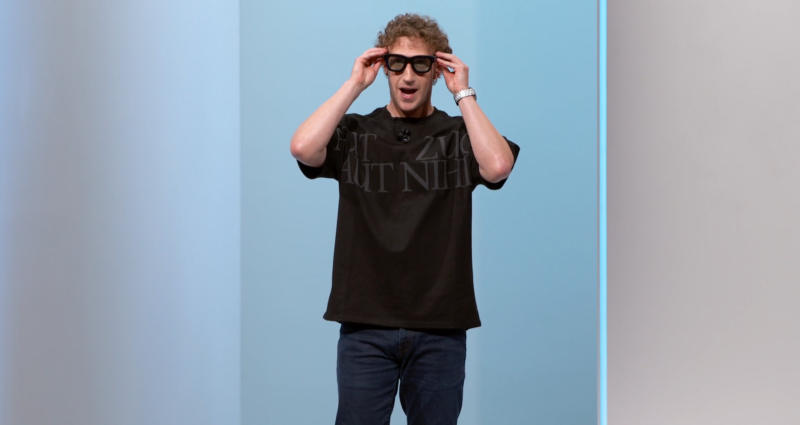
Enlarge / The future’s so bright, Mark Zuckerberg’s gotta wear shades.
Thus far, Meta’s heavily money-losing Reality Labs division has been primarily focused on bulky virtual reality headsets (and some odd, display-free Ray-Ban branded sunglasses). So when Meta CEO Mark Zuckerberg pulled out a 100 g pair of see-through, augmented-reality glasses at this year’s Meta Connect keynote, it represented a bit of a new direction for the company.
The prototype Orion AR glasses Zuckerberg showed off today don’t mean Meta will be ready to release a pair of consumer AR glasses anytime soon. But the demo represents a new vision for lightweight, wide-ranging, see-through smartglasses that Zuckerberg calls “a glimpse of the future” and “the dream of Reality Labs.”
Not your average screen
The core challenge of building a pair of comfortable augmented-reality glasses, Zuckerberg said, is that “they have to be glasses.” That means no bulky headset (a la Quest), no wires (a la Apple Vision Pro), and a weight of less than 100 grams (compared to a full 515 g for the Meta Quest 3). While there’s a tiny battery and “custom silicon” in those lightweight glasses, Zuckerberg admitted that some processing is done in a “small puck” that connects wirelessly to the glasses themselves.
-
Orion is a little thicker than actual glasses, but a whole lot smaller than VR headsets.
-
A wireless “puck” helps a bit with Orion’s processing, while a wristband provides for the “neural interface.”
-
Goodbye screens, hello “waveguides.”
-
You, too, could look this suave while wearing an AR headset.
-
Average Orion user shown in actual size.
-
The “neural interface” wristband lets Orion users interact without vocal commands or awkward, large hand gestures.
To achieve true augmented reality, Zuckerberg said Orion uses a screen that “is not actually a screen.” Instead, the glasses use tiny projectors embedded in the arms, which shoot light into specially designed waveguides. From there, the light hits “nanoscale 3D structures etched into the lenses” to show holographic images that can be layered at various depths and sizes on top of a natural view of the real world as seen through transparent lenses.
Zuckerberg said it has been a challenge making sure those images are sharp enough to capture fine details and bright enough to be seen in all sorts of lighting conditions. “This isn’t passthrough,” Zuckerberg stressed during the keynote. “This is the physical world with holograms displayed on it.”
Orion’s microprojection technology allows for a field of view that Meta says is “the largest… in the smallest AR glasses form to date.” In live demos to press, Meta said that the field of view reaches 70 degrees, compared to just 52 degrees for Microsoft’s older Hololens 2 or 50 degrees for the Magic Leap One, to cite some more limited examples of consumer AR.
To control these holograms, Orion users can use voice commands or hand- and eye-tracking like that already seen on Quest VR headsets. But Zuckerberg also talked up a “neural interface” wristband—which the company has teased previously—that can read tiny wrist and finger movements even without line of sight to the glasses themselves. That will let you interact with what’s on your glasses without having to awkwardly speak out loud or hold your hands in front of you like a zombie, Zuckerberg said.